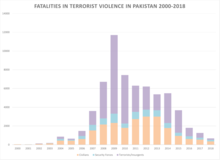
Back تروریسم در پاکستان FA Ահաբեկչությունը Պակիստանում HY Terrorismo no Paquistão Portuguese Терроризм в Пакистане Russian پاکستان میں دہشت گردی UR
The examples and perspective in this article may not include all significant viewpoints. (March 2023) |
Terrorism in Pakistan, according to the Ministry of Interior, poses a significant threat to the people of Pakistan. The wave of terrorism in Pakistan is believed to have started in 2000.[1] Attacks and fatalities in Pakistan were on a "declining trend" between 2015 and 2019, but has gone back up from 2020-2022, with 971 fatalities (229 civilians, 379 Security Force (SF) personnel and 363 terrorists) in 2022.[2]
Since 2001, the Pakistan military has launched a series of military offensives against terrorist groups in the Federally Administered Tribal Areas (FATA). The offensive brought peace in those areas and the rest of the country.[3][4] Many terrorists belonging to various terrorist groups were killed. However, some militants managed to flee to Afghanistan.[5][6] From Afghanistan, those militants continue to launch attacks on Pakistan military posts located near the border.[7] In 2017, Afghanistan's Chief Executive Abdullah Abdullah admitted that Tehrik-i-Taliban Pakistan (TTP) has a foothold in Afghanistan.[8] In 2019, the United States Department of Defense claimed that about 3,000 to 5,000 terrorists belonging to TTP are in Afghanistan.[9]

According to a report by Brown University's Watson Institute for International and Public Affairs, 23,372 Pakistani civilians and 8,832 Pakistani security personnel were killed in the War on Terrorism.[10] Moreover, according to the Government of Pakistan, the direct and indirect economic costs of terrorism from 2000–2010 total $68 billion.[11] In 2018, Pakistani newspaper Dawn News reported that the Pakistani economy suffered a total loss of $126.79 billion since 2001 due to the War on Terror.[12]
Pakistan officials often blame India and Afghanistan for supporting terrorism in Pakistan. India has denied Pakistan's allegations. However, Afghanistan has admitted to providing support for terrorist groups such as Tehrik-i-Taliban Pakistan (TTP). In 2013, the United States conducted a raid on an Afghan convoy that was taking Latif Mehsud to Kabul. Latif was a senior commander of Tehrik-i-Taliban Pakistan (TTP).[13] Afghan President's spokesperson, Aimal Faizi, told reporters that the National Directorate of Security (NDS) was working with Latif. Latif was a conduit for funding to TTP. Some of the funding for TTP might have come from NDS.[14] Former NDS head Asadullah Khalid posted a video belonging to TTP on his Twitter account where he claimed that the Badaber Camp attack was tit for tat.[15]
As of 2022, most terrorist activities in Pakistan have been concentrated in provinces of Khyber Pakhtunkhwa and Balochistan. KP accounting for 64 percent of the reported casualties (633 fatalities in 2022), followed by 26 percent in Balochistan, 5.8 percent in Sindh and 2.8 percent in Punjab. [16]
- ^ "Fatalities in terrorist violence in Pakistan 2003-2018". South Asian Terrorism Portal Index (SATP). Archived from the original on 3 August 2018. Retrieved 18 August 2018.
- ^ "Pakistan: Assessment- 2023". South Asian Terrorism Portal. Retrieved 26 July 2023.
- ^ "Once terror-hit region now ready to welcome students". Gulf News. 21 March 2019. Archived from the original on 8 November 2020. Retrieved 9 May 2019.
- ^ "Pakistan says normalcy returns to former Taliban stronghold". Associated Press (AP). 27 January 2019. Archived from the original on 3 November 2020. Retrieved 9 May 2019.
- ^ "Pakistani Taliban: Between infighting, government crackdowns and Daesh". TRT News. 18 April 2019. Archived from the original on 18 April 2019. Retrieved 9 May 2019.
- ^ "US Drone Kills Afghan-Based Pakistani Taliban Commander". Voice of America (VOA). 4 July 2018. Archived from the original on 9 May 2019. Retrieved 9 May 2019.
- ^ "Tehrik-e-Taliban Pakistan (TTP) claimed cross-border attack targeting Pakistani soldiers in North Waziristan". Islamic Theology of Counter Terrorism (ITCT). 19 September 2018. Archived from the original on 10 March 2021. Retrieved 9 May 2019.
- ^ "TTP has a foothold in Afghanistan". Dawn News. 17 November 2017. Archived from the original on 17 November 2017. Retrieved 9 May 2019.
- ^ "Lead Inspector General for Operation Freedom's Sentinel I Quarterly Report to the United States Congress I January 1, 2019 – March 31, 2019". Department of Defense Office of Inspector General (DoDIG). Archived from the original on 1 June 2019. Retrieved 12 May 2019.
- ^ "US war on terror killed at least 65,000 people in Pakistan: study". The Nation. 9 November 2018. Archived from the original on 9 November 2018.
- ^ Why they get Pakistan wrong Archived 9 November 2015 at the Wayback Machine| Mohsin Hamid| NYRoB 29 September 2011
- ^ Cite error: The named reference
lossesfromwas invoked but never defined (see the help page). - ^ Matthew Rosenberg. "U.S. Disrupts Afghans' Tack on Militants". New York Times. Archived from the original on 29 October 2013. Retrieved 28 October 2013.
- ^ Umar Farooq (1 January 2014). "Afghanistan-Pakistan: The covert war". The Diplomat. Archived from the original on 4 January 2014.
Latif spent much of his time since 2010 between Afghanistan and Pakistan, and it is believed he was a conduit for funding to the TTP. It now appears some of that funding might have come from Afghanistan's intelligence agency, the National Directorate of Security (NDS)....Yet, the president's spokesperson, Aimal Faizi, openly told reporters the NDS had been working with Latif "for a long period of time." Latif, Faizi said, "was part of an NDS project like every other intelligence agency is doing."
- ^ "Former Afghan intelligence head says Badaber attack is a 'tit for tat', terms TTP militants as 'martyrs'". Daily Pakistan. 19 September 2015. Archived from the original on 20 September 2015.
- ^ "Pakistan's Alarming Rise in Terrorism Is Fueled by Afghanistan". thediplomat.com. Archived from the original on 18 April 2023. Retrieved 18 April 2023.